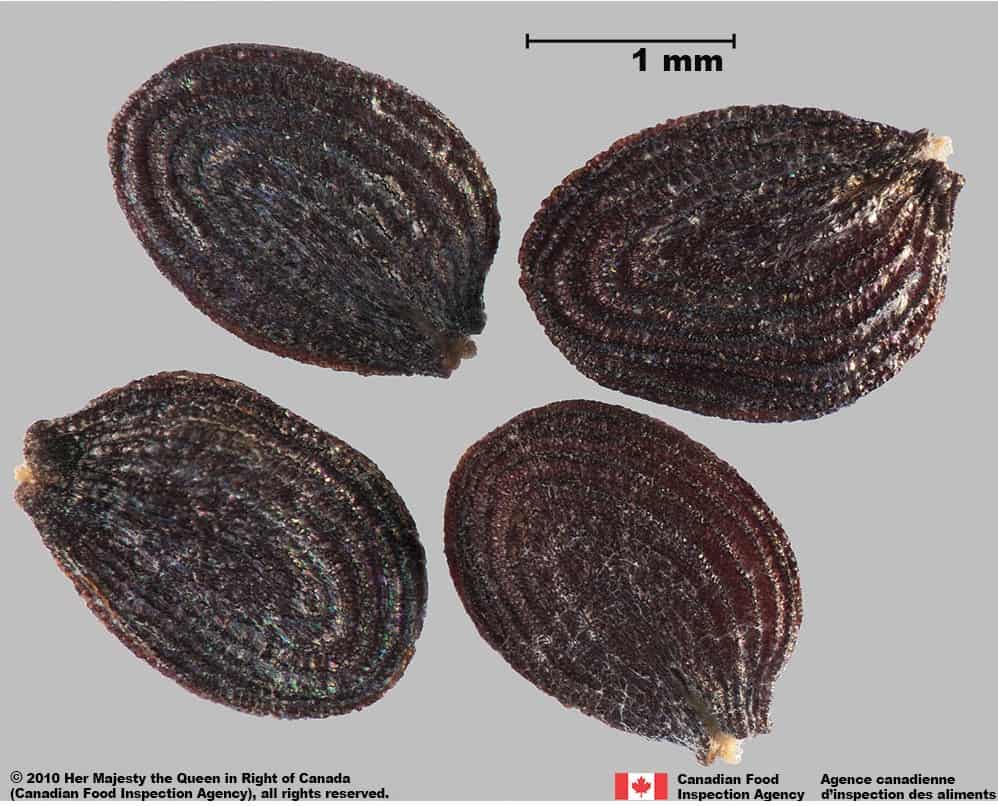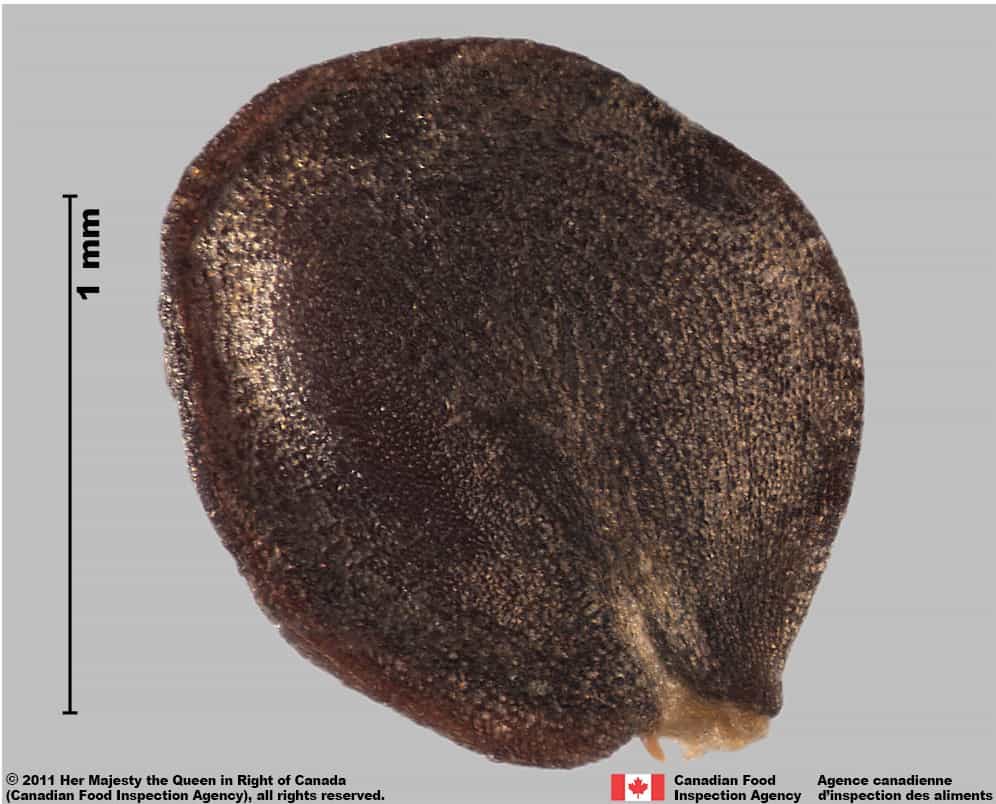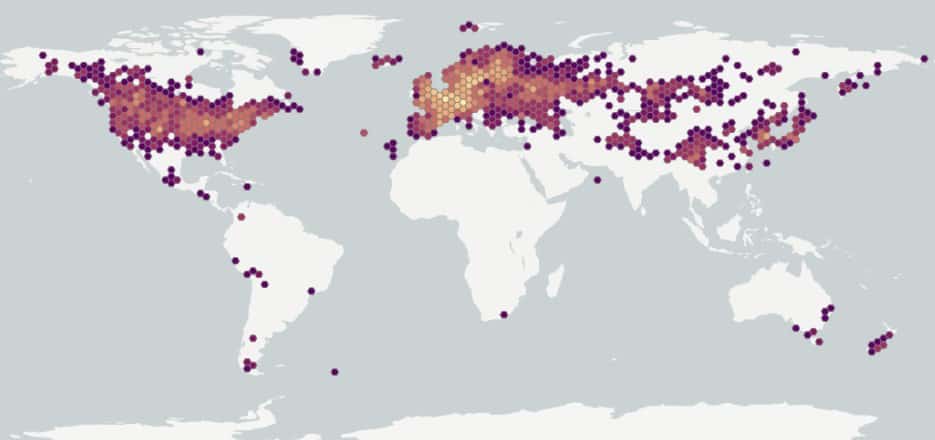Thlaspi arvense
Overview
Aperçu
Regulation :
Remarques Réglementation:
- CFIA Weed Seeds Order - Class 3: Secondary Noxious Weed Seeds
- Quarantine lists of countries e.g. Mexico *may be updated without notice
Regulation Notes:
Distribution :
Répartition :
Native to Europe and Asia and introduced in North America, southern South America, northern Africa, South Africa, Australia, New Zealand, and beyond its native range in northern Europe (USDA-ARS 2021). Widespread in temperate regions of the northern hemisphere and recently spread to temperate regions of the southern hemisphere (Warwick et al. 2002). Occurs throughout Canada (Brouillet et al. 2010+) and is most abundant in the prairie provinces (Warwick et al. 2002).
Habitat and Crop Association :
Habitat et Cultures Associées :
Cultivated fields, old fields, gardens, pastures, rangelands, meadows, thickets, woods, irrigated areas, sloughs, beaches, roadsides, lawns, railway lines and disturbed areas (FNA 1993+; Warwick et al. 2002; Darbyshire 2003). A serious weed of pastures and cereal, oilseed, forage and vegetable crops (Warwick et al. 2002; CABI 2021).
Economic Use, cultivation area, and Weed Association :
Utilisation économique, zone de culture et association de mauvaises herbes :
Duration of Life Cycle :
Durée du cycle vital:
Annual or Winter annual
Dispersal Unit Type :
Type d’unité de dispersion :
Seed
General Information
RENSEIGNEMENTS GÉNÉRAUX
Thlaspi arvense was first introduced into Michigan in 1701 (Royer and Dickinson 1999) and is now found in all of the United States except for Hawaii (NatureServe 2015). One plant is capable of producing up to 20,000 seeds, which can remain viable for 20 to 30 years (CABI 2021).
Not only does T. arvense reduce crop yields, it also decreases crop quality by increasing the erucic acid content of the oil produced (Warwick et al. 2002). T. arvense can be toxic to cattle, causing symptoms such as abortion, colic, and sometimes death (Warwick et al. 2002).
.
Thlaspi arvense plant (Mary Ellen (Mel) Harte, Bugwood.org)
Identification
Identification
-
Silicle
Size
- Silicle length: 9.0 – 20.0 mm; width: 7.0 – 20.0 mm (FNA 1993+)
Shape
- Egg-shaped or round with a V-shaped notch at the end opposite the stalk
- Central portion of silicle inflated
Surface Texture
- Surface is smooth with a vein pattern
Colour
- Silicle is dull straw yellow
Other Features
- Silicle winged around an inflated centre, the wing is 1.0 – 1.5 mm wide at the stalk end, and 3.5 – 5.0 mm wide at the notched end (FNA 1993+)
- Silicle holds 6 – 16 seeds (FNA 1993+)

Thlaspi arvense (stinkweed) silicle


-
Seed
Size
- Seed length*: 1.9 – 2.7 mm; width: 1.3 – 1.7 mm
*Note: minimum and maximum of 20 seeds in a normal range of this species using image measurement (ISMA 2020)
Shape
- Seed oval shaped, compressed in 3 dimensions
Surface Texture
- Seed surface ridged in a series of circles following the shape of the seed
Colour
- Seeds are shiny dark brown coloured
- Immature seeds are shiny reddish-brown coloured
Other Features
Hilum & Hilum area
- Hilum has a notch along the edge of the seed with 2 narrow protruding lobes and tissue inside
- Circular ridges come together at the hilum area

Stinkweed (Thlaspi arvense) seeds




-
Embryo
Size
- Embryo fills the seed
Shape
- Embryo is bent
Endosperm
- Endosperm is scant or lacking
Other Features
- Nutritive tissue contained within oval shaped cotyledons
- Cotyledons are oval shaped, orange coloured, soft and oily, with a ridged reticulate surface texture
Identification Tips
CONSEILS POUR L’IDENTIFICATION
Circular ridges on the seed surface combined with the compressed oval shape distinguishes the seed of Thlaspi arvense from similar species. Alliaria petiolata seeds are also dark brown with a ridged surface, but they are a cylindrical shape. Berteroa incana seeds are a similar brown colour, oval shape and notched hilum, but the surface is smoother.

Stinkweed (Thlaspi arvense) seed




Additional Botany Information
AUTRES RENSEIGNEMENTS BOTANIQUES
Similar Species
ESPÈCES SEMBLABLES
Similar species are based on a study of seed morphology of various species, and those with similar dispersal units are identified. The study is limited by physical specimen and literature availability at the time of examination, and possibly impacted by the subjectivity of the authors based on their knowledge and experience. Providing similar species information for seed identification is to make users aware of similarities that could possibly result in misidentification.
Berteroa incana (L.) DC. (hoary alyssum)
B. incana seeds are smaller (length*: 1.1- 2.2 mm; width: 0.9 – 1.8), with a ridged reticulate surface and lack the concentric ridges of T. arvense seeds.
Alliaria petiolata (M. Bieb.) Cavara & Grande (garlic mustard )
A. petiolata seeds are larger (length*: 2.3 – 3.6 mm; width: 0.8 – 1.3 mm), elongate oval, cylindrical in 3 dimensions and compressed only at the hilum end. T. arvense seeds are smaller, oval shaped and compressed.
*Note: minimum and maximum of 10 seeds in a normal range of this species using image measurement (ISMA 2020)
Click to select species
Cliquez pour sélectionner les espèces

Berteroa incana

Alliaria petiolata
Comparison Window
Fenêtre de comparaison
MAIN SPECIES
ESPÈCES PRINCIPALES
Thlaspi arvense

Thlaspi arvense
Brassicaceae
Stinkweed (Thlaspi arvense) seeds
MAIN SPECIES
ESPÈCES PRINCIPALES
Thlaspi arvense

Thlaspi arvense
Brassicaceae
Stinkweed (Thlaspi arvense) seeds
MAIN SPECIES
ESPÈCES PRINCIPALES
Thlaspi arvense

Thlaspi arvense
Brassicaceae
Stinkweed (Thlaspi arvense) seeds
MAIN SPECIES
ESPÈCES PRINCIPALES
Thlaspi arvense

Thlaspi arvense
Brassicaceae
Stinkweed (Thlaspi arvense) seed
MAIN SPECIES
ESPÈCES PRINCIPALES
Thlaspi arvense

Thlaspi arvense
Brassicaceae
Thlaspi arvense (stinkweed) silicle
MAIN SPECIES
ESPÈCES PRINCIPALES
Thlaspi arvense

Thlaspi arvense
Brassicaceae
Thlaspi arvense (stinkweed) silicle and seeds
SIMILAR SPECIES
ESPÈCES SEMBLABLES
Berteroa incana

Berteroa incana
Brassicaceae
Hoary alyssum (Berteroa incana) seeds
SIMILAR SPECIES
ESPÈCES SEMBLABLES
Berteroa incana

Berteroa incana
Brassicaceae
Hoary alyssum (Berteroa incana) seed
Need ID Help?
Besoin d’aide pour l’identification?
Reference(s)
Référence(s)
Brouillet, L., Coursol, F., Meades, S. J., Favreau, M., Anions, M., Bélisle, P. and Desmet, P. 2010+. VASCAN, the database of vascular plants of Canada. http://data.canadensys.net/vascan/ Accessed April 29, 2021.
Centre for Agriculture and Bioscience International (CABI). 2021. Invasive Species Compendium, CAB International, Wallingford, UK. https://www.cabidigitallibrary.org/journal/cabicompendium Accessed April 29, 2021.
Darbyshire, S. J. 2003. Inventory of Canadian Agricultural Weeds. Agriculture and Agri-Food Canada, Research Branch. Ottawa, ON.
Flora of North America (FNA) Editorial Committee, eds. 1993+. Flora of North America North of Mexico [Online]. 22+ vols. New York and Oxford. Accessed December 29, 2022.
Global Biodiversity Information Facility (GBIF) Secretariat. 2022. https://doi.org/10.15468/39omei Accessed via https://www.gbif.org/species/3052680 Accessed December 29, 2022.
Government of Canada (GC). 2016. Canadian Weed Seeds Order. https://laws-lois.justice.gc.ca/eng/regulations/SOR-2016-93/page-2.html (English) https://laws-lois.justice.gc.ca/fra/reglements/DORS-2016-93/page-2.html (French)
International Seed Morphology Association (ISMA). 2020. Method for Seed Size Measurement. Version 1.0. ISMA Publication Guide.
NatureServe. 2015. NatureServe Explorer: An online encyclopedia of life [web application]. Version 7.1. NatureServe, Arlington, Virginia, http://explorer.natureserve.org Accessed May 30, 2016.
Royer, F. and Dickinson, R. 1999. Weeds of Canada and the Northern United States. The University of Alberta Press/Lone Pine Publishing, Edmonton, Alberta.
U.S. Department of Agriculture-Agricultural Research Services (USDA-ARS). 2021. Germplasm Resources Information Network (GRIN), https://npgsweb.ars-grin.gov/gringlobal/taxon/taxonomysimple.aspx Accessed April 29, 2021.
Warwick, S. I., Francis, A. and Susko, D. J. 2002. The biology of Canadian weeds. 9. Thlaspi arvense L. (updated). Canadian Journal of Plant Science 82: 803–823.




